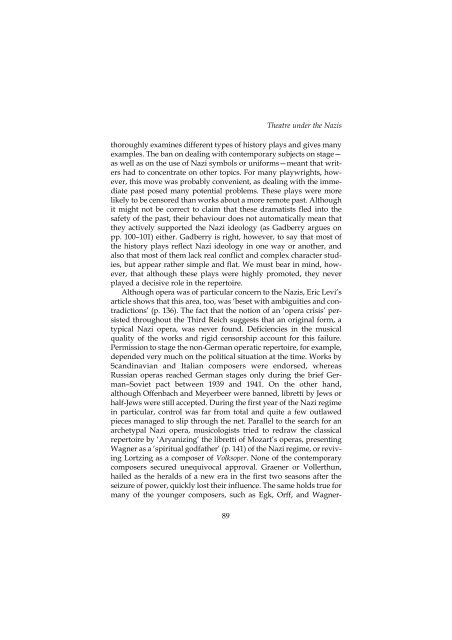Download - German Historical Institute London
Download - German Historical Institute London
Download - German Historical Institute London
Create successful ePaper yourself
Turn your PDF publications into a flip-book with our unique Google optimized e-Paper software.
thoroughly examines different types of history plays and gives many<br />
examples. The ban on dealing with contemporary subjects on stage—<br />
as well as on the use of Nazi symbols or uniforms—meant that writers<br />
had to concentrate on other topics. �or many playwrights, however,<br />
this move was probably convenient, as dealing with the immediate<br />
past posed many potential problems. These plays were more<br />
likely to be censored than works about a more remote past. Although<br />
it might not be correct to claim that these dramatists fled into the<br />
safety of the past, their behaviour does not automatically mean that<br />
they actively supported the Nazi ideology (as Gadberry argues on<br />
pp. 100–101) either. Gadberry is right, however, to say that most of<br />
the history plays reflect Nazi ideology in one way or another, and<br />
also that most of them lack real conflict and complex character studies,<br />
but appear rather simple and flat. We must bear in mind, however,<br />
that although these plays were highly promoted, they never<br />
played a decisive role in the repertoire.<br />
Although opera was of particular concern to the Nazis, Eric Levi’s<br />
article shows that this area, too, was ‘beset with ambiguities and contradictions’<br />
(p. 136). The fact that the notion of an ‘opera crisis’ persisted<br />
throughout the Third Reich suggests that an original form, a<br />
typical Nazi opera, was never found. Deficiencies in the musical<br />
quality of the works and rigid censorship account for this failure.<br />
Permission to stage the non-<strong>German</strong> operatic repertoire, for example,<br />
depended very much on the political situation at the time. Works by<br />
Scandinavian and Italian composers were endorsed, whereas<br />
Russian operas reached <strong>German</strong> stages only during the brief <strong>German</strong>–Soviet<br />
pact between 1939 and 1941. On the other hand,<br />
although Offenbach and Meyerbeer were banned, libretti by Jews or<br />
half-Jews were still accepted. During the first year of the Nazi regime<br />
in particular, control was far from total and quite a few outlawed<br />
pieces managed to slip through the net. Parallel to the search for an<br />
archetypal Nazi opera, musicologists tried to redraw the classical<br />
repertoire by ‘Aryanizing’ the libretti of Mozart’s operas, presenting<br />
Wagner as a ‘spiritual godfather’ (p. 141) of the Nazi regime, or reviving<br />
Lortzing as a composer of Volksoper. None of the contemporary<br />
composers secured unequivocal approval. Graener or Vollerthun,<br />
hailed as the heralds of a new era in the first two seasons after the<br />
seizure of power, quickly lost their influence. The same holds true for<br />
many of the younger composers, such as Egk, Orff, and Wagner-<br />
89<br />
Theatre under the Nazis













